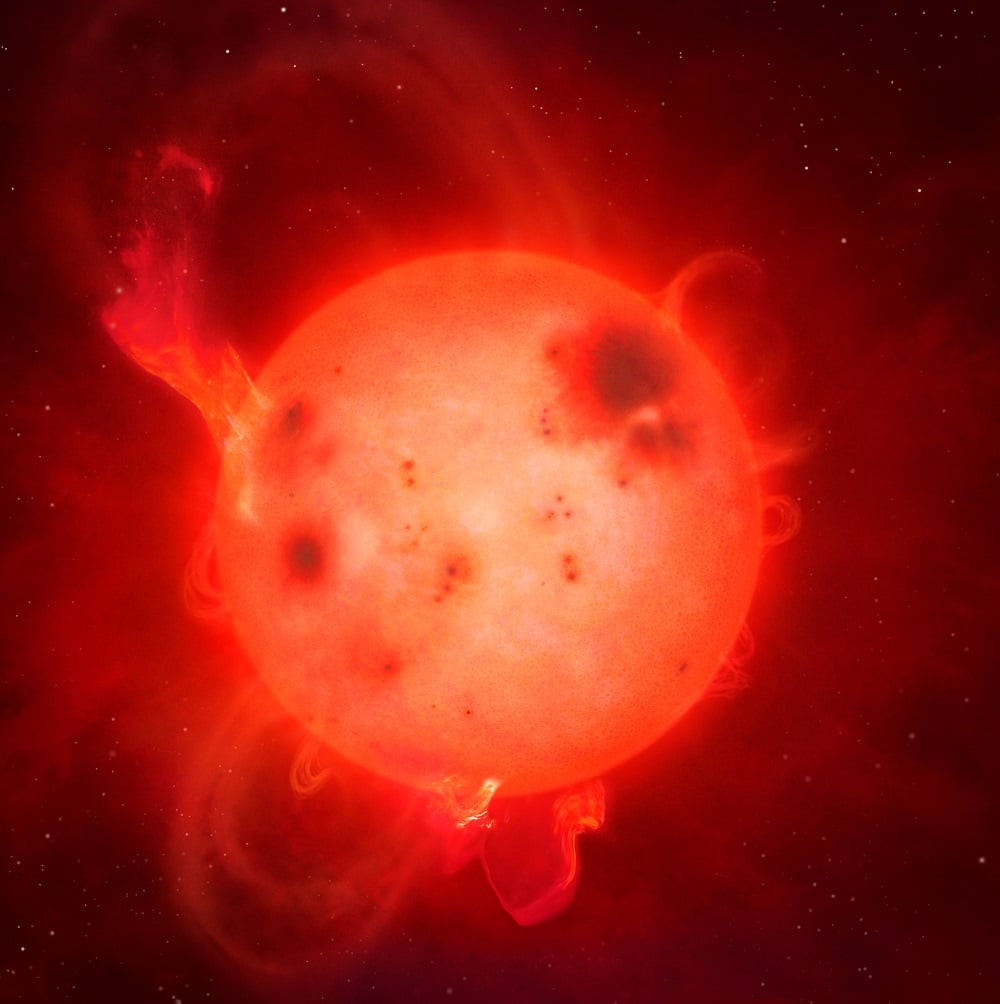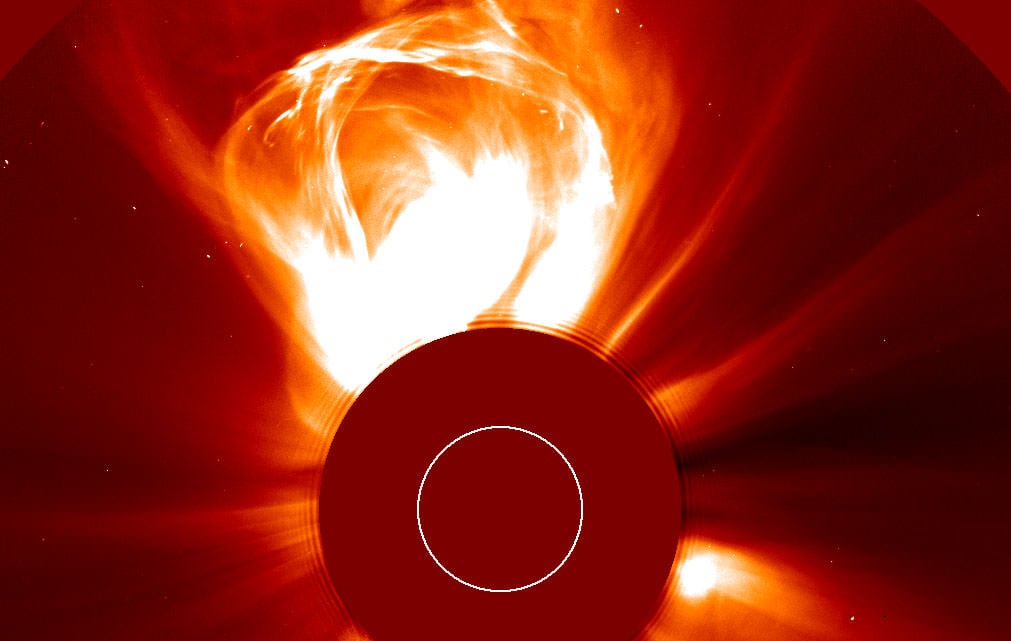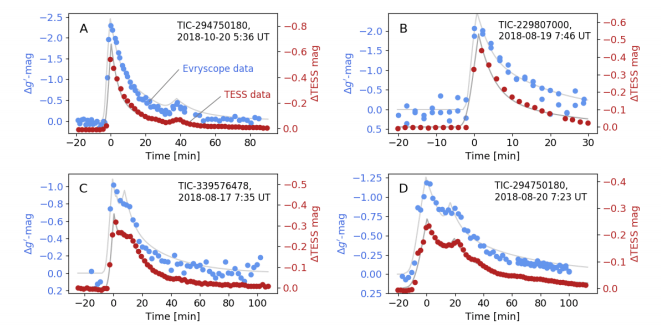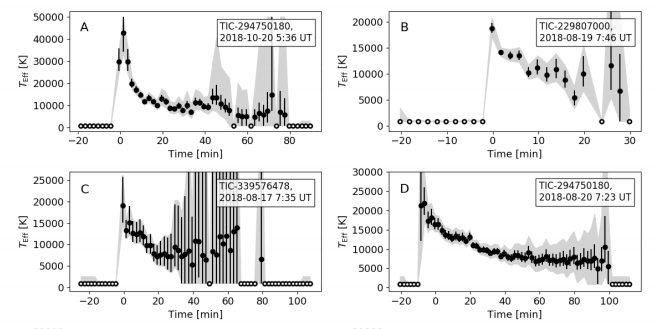Star's can be full of surprises; some of them nasty. While our own Sun appears pretty placid, science has shown us that's not the case. Coronal mass ejections and solar flares are the Sun's angry side.
And the Sun has only a mild case of the flares, compared to some other stars.
Some stars experience what are called superflares. These are extremely powerful events that dwarf the flares our Sun produces. They're up to 10,000 times more energetic than the Sun's milder flares. And these powerful flares and their ultraviolet energy can be devastating to life on any nearby planets.
But just how bad is all this flaring for life on any nearby planets? How can astronomers look at a distant exoplanet near one of these flaring stars, and make an accurate judgment of how deadly it is? How can they rule out habitability on a planet next to one of these hyperactive stars?
A team of researchers tackled that question in a new study titled " EvryFlare III: Temperature Evolution and Habitability Impacts of Dozens of Superflares Observed Simultaneously by Evryscope and TESS." The lead author is Ward S. Howard, a doctoral student in the Department of Physics and Astronomy at UNC-Chapel Hill. The study is available on the pre-press site arxiv.org, prior to being published in The Astrophysical Journal.
When a star flares, there's a sudden and unpredictable increase in its brightness, resulting from magnetic energy in the star's atmosphere. That brightness can be across the electromagnetic spectrum, though this study is focused on UV from flares. Most flare stars are red dwarfs, and therein lies the problem. Red dwarfs are the most common type of star in the Milky Way—some studies say 75% are red dwarfs—and the most common host star for exoplanets. (We use the term "red dwarfs" with one caution. It's not a precise scientific name. In this study, the team is focused on M-dwarfs, and the rocky, potentially habitable planets that orbit M-dwarfs, called M-Earths.
This study is designed to aid future missions that hunt for exoplanets and to put some limits on habitability. Astronomers know that UV energy is deadly for life, but it's not a yes or no issue. How much is bad for which types of organisms? How might some life survive on some planets exposed to these hyper-energetic events?
"We found planets orbiting young stars may experience life-prohibiting levels of UV radiation, although some micro-organisms might survive," said lead author Howard in a press release.
This study is the largest-ever survey ever done of stellar flares. The team of researchers used two telescopes in their work: NASA's TESS (Transiting Exoplanet Survey Satellite) and the Evryscope Telescope at UNC-Chapel Hill.
Astronomers have studied superflares before, but this is the most comprehensive effort so far. They're rare, so studying them is difficult. Past studies have only looked at a few, so it was difficult to draw any conclusions from them. There was no way of knowing, for example, if the thermal emissions from superflares are consistently higher than for regular flares.
But we do know that all of that radiation is deadly. "Frequent superflares can erode the ozone layer of an Earth-like atmosphere and allow lethal amounts of UV surface flux," the authors write.
On the other hand, some amount of flaring energy may help drive the appearance of life on a planet. "Conversely, too few flares may result in insufficient surface radiation to power pre-biotic chemistry," they write.
This new work expands on previous efforts, which focused only on a few flares. In this study, the team measured "temperatures at 2 min cadence for 44 superflares from 27 K5-M5 dwarfs." The team discovered a relationship between a superflare's size and its temperature. A flare's temperature determines the amount of deadly radiation it produces.
A superflare's peak is of particular interest to astronomers. The peak lasts between about 5 and 15 minutes, and during that time it produces most of its UV energy. The team used both telescopes to monitor the flaring activity at two-minute intervals. That ensured that during each flare's peak, multiple measurements were taken. Because of this method of observation, the team was able to find out how long these flares blast their nearby planets with peak UV radiation.
There's some complexity in these results, and some of the conclusions are preliminary. But that's expected from the first study of this size.
There are two types of flares: classic and complex. A classic superflare has a single peak, while a complex superflare has multiple peaks. "Complex flares comprise the majority of the largest flares," the authors write, "making statistical comparisons of the temperatures of simple and complex flares challenging." The authors also point out that it's not always clear what category a flare best fits into.
There's some additional uncertainty in the correlation between flare energy and flare temperature. "While the total flare energy of our sample appears to correlate with the peak flare temperature, the relationship may only hold for classical flares and not complex flares. The large amplitude and short duration of a classical flare may produce the same energy as a complex flare with a small amplitude and long duration."
There are also some problems in correlating UV emissions with optical emissions. "The relationship between UV and optical emission is not yet well-understood," the authors write. "As a result, estimating the UV emission of stellar flares from the optical continuum may under-represent the true UV flux."
Some of these details will hopefully be worked out in future studies. But this study is still important, even with some of the outstanding questions around superflares. "We demonstrate for the first time in a large sample that flare energy and impulse are predictors of the optical temperature evolution of M-dwarf superflares."
In their paper, the team mentions future research they'd like to do. They want to observe more flares at the two-minute cadence so they can better understand the energy and impulse relationships for each spectral sub-type of stars. They also need higher cadence measurements to catch impulses that can occur on several-second timescales.
As it stands now, TESS is already watching high-priority flare stars from this study. So we may learn more about superflares and habitability sooner rather than later. And, like many issues in astronomy, the upcoming James Webb Space Telescope can also make use of these results.
"Longer-term these results may inform the choice of planetary systems to be observed by NASA's James Webb Space Telescope based on the system's flaring activity," said study co-author Nicholas M. Law, associate professor of physics and astronomy at UNC-Chapel Hill and principal investigator of the Evryscope telescope.
More:
- Press Release: New research explores how superflares affect planets’ habitability
- New Research: EVRYFLARE III: TEMPERATURE EVOLUTION AND HABITABILITY IMPACTS OF DOZENS OF SUPERFLARES OBSERVED SIMULTANEOUSLY BY EVRYSCOPE AND TESS
- Universe Today: Without a Magnetosphere, Planets Orbiting Flare Stars Don’t Stand a Chance
 Universe Today
Universe Today




